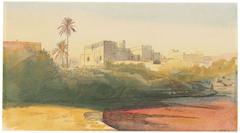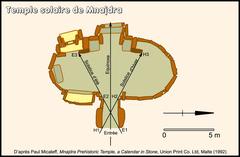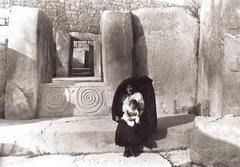
Tarxien Unveiled: Your Playful Passport to Malta’s Quirkiest Secrets
Date: 04/07/2025
Why Tarxien Will Tickle Your Senses and Steal Your Heart
Imagine wandering sun-drenched Maltese streets, gelato in hand, when suddenly—5,000 years of mystery rise before you in the form of ancient limestone giants. Welcome to Tarxien, where history vibrates beneath your feet, whispers from spiral-carved stones, and mingles with the scent of wild fennel and pastizzi. Here, the past is a lively companion—inviting you to time-travel through labyrinthine temples predating the Pyramids and out-mystifying Stonehenge (Google Arts & Culture).
Tarxien is more than a UNESCO World Heritage Site; it’s Malta’s ultimate playground for the curious, the adventurous, and the pastry-obsessed. Think Indiana Jones meets The Great British Bake Off, with a dash of local legend and sun-soaked charm (MaltaInfoGuide). Each twist in the temple paths is a choose-your-own-adventure; each spiral carving, a riddle older than your ancestors. Whether you’re a history enthusiast, a family of explorers, or simply searching for the best ricotta pastizzi, Tarxien welcomes you—with the mysterious “Fat Lady” statue perhaps giving a knowing wink (The Ancient Connection).
This guide is part treasure hunt, part comedy hour, part sensory feast. You’ll pick up Maltese phrases, bust a few myths (no, aliens did NOT build these temples—credit goes to ingenious Neolithic islanders), and discover that the best views—and snacks—are often just off the main path. Ready to unlock the secrets and stories of Tarxien? Set your time machine to “Neolithic,” and let’s begin (Nanovic Institute, University of Notre Dame).
Overview: Tarxien’s Unexpected Wonders
Origins and Chronology of the Tarxien Temples
The Tarxien Temple Complex, located in Malta’s Port region, is among the Mediterranean’s most significant and best-preserved megalithic sites. The complex comprises four interlinked temple structures built between 3600 and 2500 BCE, with evidence of use extending into the Bronze Age (ca. 2400–1500 BCE) (Google Arts & Culture; MaltaInfoGuide). The earliest, the Far East Temple, dates to 3600–3200 BCE. The South, Central, and East Temples were constructed during the Tarxien phase (ca. 3150–2500 BCE) (The Ancient Connection).
Cremation remains and Bronze Age artifacts reveal that the temples were repurposed as a cremation cemetery after their original ritual use (Google Arts & Culture).
Architectural Features and Layout
The Tarxien Temples are renowned for sophisticated planning and construction:
- Far East Temple: The oldest, with a five-apse plan, survives only to near ground level but demonstrates early temple design (Google Arts & Culture).
- South Temple: Built during the Tarxien phase, it is the most elaborately decorated, featuring relief sculptures, spiral motifs, and the lower part of a colossal anthropomorphic statue (MaltaInfoGuide).
- Central Temple: Notable for its unique six-apse plan and evidence of arched roofing, with refined stonework and advanced quarrying techniques.
- East Temple: Characterized by well-cut slab walls and ‘oracle’ holes, though interiors are less refined than the others.
Constructed from massive limestone blocks, some weighing several tons, the temples’ interiors suggest deliberate partitioning for ritual or social functions (Google Arts & Culture).
Artistic and Ritual Significance
Tarxien is the richest Maltese temple in sculptural decoration and iconography. Intricate reliefs depict spirals, animals (bulls, goats, pigs, rams), altars, and statues (MaltaInfoGuide). The colossal “Fat Lady” statue is a remarkable anthropomorphic representation (Google Arts & Culture). Altars, animal bones, and flint knives beneath decorated slabs suggest ritual activities, likely related to fertility and ancestor worship.
The artistic style is unique to Malta, with no direct parallels elsewhere, reflecting the island’s independent cultural development (Google Arts & Culture).
Archaeological Discovery and Excavation
Discovered in 1913 when local farmers’ ploughs struck buried stones, the Tarxien Temples were excavated under Sir Themistocles Zammit (1915–1919) (The Ancient Connection). These excavations placed Malta on the global archaeological map, inviting comparisons with Stonehenge and Minoan Crete (Google Arts & Culture).
Preservation efforts included rebuilding sections as rubble walls, interventions in the 1920s, and further excavations after World War II by J.G. Baldacchino (Wikipedia). Artifacts were donated to the British Museum in 1923; the site was protected by the Antiquities List in 1925.
Preservation and Heritage Management
Tarxien’s preservation reflects both local and colonial priorities. During British rule (1800–1964), the site’s academic and symbolic value was recognized (Nanovic Institute, University of Notre Dame). European interest in the origins of civilization made Tarxien a research and heritage tourism focal point.
Modern conservation includes an elevated walkway (2012) and protective shelters (2015), funded by the European Regional Development Fund (Wikipedia; MaltaInfoGuide). These measures address threats such as limestone deterioration and visitor impact.
UNESCO World Heritage Status and Cultural Legacy
In 1992, the Tarxien Temples joined other Maltese megalithic sites as a UNESCO World Heritage Site (Wikipedia). The complex is central to Malta’s identity and heritage tourism. Tarxien stands as a testament to prehistoric achievement and the ongoing challenges of heritage management (Nanovic Institute, University of Notre Dame). Interpretation and preservation are continually updated with new research and changing attitudes toward cultural memory.
Practical Information for Visitors
- Location: Neolithic Temples Street, Tarxien TXN 1063, Malta. Near the Ħal Saflieni Hypogeum and Paola village (MaltaInfoGuide).
- Access: By car (limited parking) or public transport, including the Red South Route sightseeing bus.
- Facilities: Elevated walkways, shelters, and nearby amenities in Paola.
- Opening Hours & Admission: See Heritage Malta for current times and prices.
- Tips: The site is exposed—bring sun protection. Combine your visit with the Hypogeum for a full prehistoric experience.
For more details: MaltaInfoGuide, Google Arts & Culture.
Unlocking Tarxien: A Playful Field Guide
The Grand Entrance
At Tarxien, the stones tell their own stories. Four temples, each unique, form a labyrinth of history. Start at the oval forecourt—run your fingers over pitted limestone and imagine ancient rituals, bustling markets, and the aroma of wild herbs mixing with sizzling pastizzi.
The Art of Stone
Tarxien’s reliefs—spirals, sheep, bulls, and the famed “Fat Lady” statues—are Malta’s ancient answer to social media. Discover mysterious spirals (some say they’re calendars, others, ancient doodles), altars, and carved basins used in rituals. Archaeological finds include animal bones and evidence of ancient cremation ceremonies.
Hidden Corners & Local Legends
The temples were unearthed by a farmer in 1913—locals once believed giants (Il-Gganti) built them. Venture into quieter apses, listen for the whispers of history, and thank the “giants” for their handiwork.
Tarxien in Pop Culture
Tarxien hasn’t starred in blockbusters (yet), but its megaliths inspire artists and writers. Imagine a Game of Thrones prequel or Lara Croft deciphering spiral codes here.
Conservation
Time and elements threaten the temples, but modern conservation—including shelters and digital scans—protects them for future generations. Elevated pathways keep visitors close but the stones safe.
The Tarxien Challenge
- Spot the Fat Lady: Not all are plump!
- Decode the Spirals: Share your theory with a guide.
- Speak Maltese: Try “Merħba!” (“Welcome!”) and “Grazzi” (“Thank you”).
Local Flavors
Post-adventure, explore Tarxien’s heart: church bells, market bustle, and the irresistible aroma of fresh bread and rabbit stew (fenkata). Sample pastizzi and sip Kinnie soda.
When to Visit
- Spring: Wildflowers and fewer crowds.
- Summer: Bring a hat—stones soak up the sun.
- Autumn: Golden light for epic photos.
- Festivals: Experience Tarxien’s vibrant parades and music.
Practical Magic
- Opening Hours: Year-round (except holidays); check Heritage Malta.
- Tickets: Support conservation.
- Facilities: Restrooms, ramps, signage, and accessibility.
- Photo Policy: Snap away—no flash or drones, please.
FAQs
- Touch the stones? Only with your imagination.
- Why headless statues? Ritual or fashion; the debate continues.
- Haunted? Only by echoes of millennia.
- Dress code? Comfy shoes recommended.
Myth Busting
- Aliens built Tarxien? Nope, just ingenious locals.
- Just rocks? It’s a library, calendar, art gallery, and sacred site in one.
Tarxien Unplugged: An Archaeological Treasure Hunt
Level One: The Temple Trail
Spot spiral carvings, listen for sparrows, and wander among six-apsed wonders. Guided tours bring the history to life, blending archaeological facts with lively storytelling.
Level Two: Secret Shortcuts & Local Legends
Beyond the temples, hidden lanes shaded by carob trees offer respite. Find St. Mary’s Chapel at noon for a stroke of luck—or a glimpse of the local cat, Sir Lancelot. Sunset is best enjoyed from the stone wall behind the Central Temple.
Level Three: Eat, Drink, and Speak Like a Local
Hunt for the best pastizzi (“waħda bil-irkotta, jekk jogħġbok” – “one with ricotta, please”). Try basic Maltese phrases:
- “Bongu!” – Good morning!
- “Kemm hu sabiħ hawn!” – How beautiful it is here!
- “Fejn hu l-aqwa kafè?” – Where’s the best café?
Level Four: Choose Your Own Tarxien Adventure
- Dawn Raider: Sunrise at the temples, a visit to the Hypogeum (book ahead), and coffee in the square.
- Festival Seeker: Experience spring festas, street food, and local music.
- Family Time-Traveler: Scavenger hunts, pottery workshops, and pronunciation contests.
Level Five: Myths, Mind-Blowers & Movie Magic
- Myth: Built by giants—reality: determined Neolithic islanders.
- Local lore: Spiral carvings as ancient doodles or tic-tac-toe.
- On film: Tarxien has appeared in documentaries and Maltese cinema.
Level Six: Etiquette—Do’s & Don’ts
- Do: Greet with “Bongu!”, dress modestly, and try every pastry.
- Don’t: Climb stones, mistake fireworks for UFOs, or skip the gift shop.
Level Seven: Practical Info
- Hours: 9:00–17:00 (last entry 16:30). Closed select holidays.
- Prices: Adults €6, Students/Seniors €4.50, Kids €3, Infants free.
- Tickets: Online or on-site.
- Accessibility: Marked wheelchair-friendly paths; ask staff for assistance.
- Restrooms & shade: Available; bring a hat in summer.
Season by Season
- Spring: Wildflowers and festas.
- Summer: Early or late visits for comfort.
- Autumn: Peaceful and golden.
- Winter: Mysterious atmosphere; festive lights.
FAQs
- Wheelchair accessible? Mostly; some uneven paths.
- Best time? Early morning or late afternoon.
- Kids welcome? Yes—great for families.
- Photography? Yes—no flash inside.
- Nearby food? Follow the locals for the tastiest snacks.
The Grand Finale: Make Tarxien Your Own Adventure
As the sun slips behind Tarxien’s megaliths, you’ll find this isn’t merely a site you visit—it’s a living riddle, a memory in the making. Every limestone block tells a story; every spiral whispers of eternity (Google Arts & Culture). Whether you came for archaeology or for culinary quests, Tarxien invites you to keep exploring, questioning, and enjoying the everyday magic of Malta (Wikipedia; MaltaInfoGuide).
To make your adventure truly unforgettable, download Audiala—the app that unlocks hidden stories, interactive quests, and expert audio guides. Tarxien’s stones are waiting—and your journey has only just begun. See you in Tarxien, ħabib (“friend”), where history is alive and always waiting for curious explorers (Heritage Malta; Tarxien Local Council).
Local Legends and Insider Sources
- Google Arts & Culture. (n.d.). Astonishing Megalithic Temples: The Tarxien Complex. (Google Arts & Culture)
- MaltaInfoGuide. (n.d.). Tarxien Temples. (MaltaInfoGuide)
- The Ancient Connection. (n.d.). Tarxien Megaliths. (The Ancient Connection)
- Wikipedia. (n.d.). Tarxien Temples. (Wikipedia)
- Nanovic Institute, University of Notre Dame. (n.d.). Malta: Tarxien Temples. (Nanovic Institute, University of Notre Dame)
- Heritage Malta. (n.d.). (Heritage Malta)
- Tarxien Local Council. (n.d.). (Tarxien Local Council)
Audiala2024


